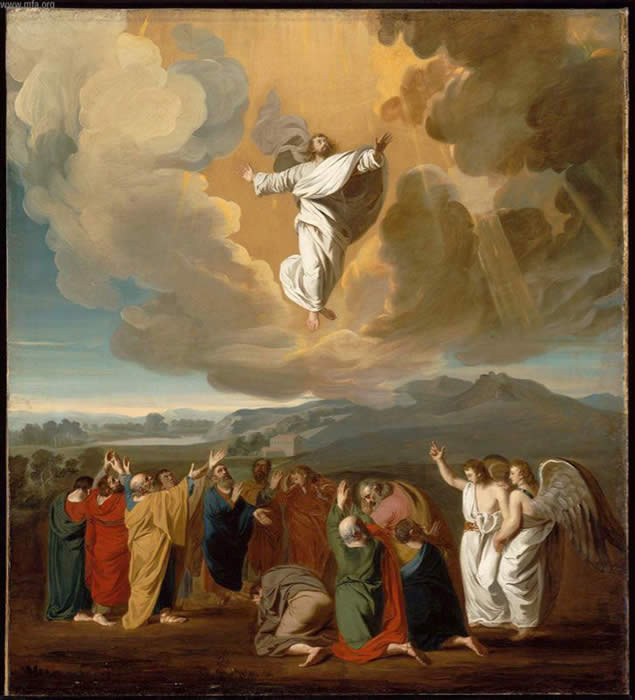
-detail of the Ascension, Saint Dié manuscript

-Eastern France (Saint-Die) manuscript, 1504-1514

-by Joseph Heschmeyer, a former lawyer and seminarian, he blogs at Shameless Popery.
“It’s not hard to understand why we would celebrate Good Friday (Jesus atones for our sins on the Cross) and Easter Sunday (Jesus rises again, conquering death). But Ascension Thursday commemorates Jesus’ ascension into heaven. Why, from the perspective of one of those “left behind” on Earth, is that something to celebrate?
It’s easy to misunderstand the Ascension, as if Christ were abandoning his disciples. But he promised that this wouldn’t happen, saying “I will not leave you desolate” (John 14:18) and “I am with you always, to the close of the age” (Matt. 28:20). Similarly, we misunderstand the Ascension if we imagine that Jesus is returning to heaven, as if he ever left heaven in the first place. As St. Augustine points out, Jesus “did not leave heaven when he came down to us; nor did he withdraw from us when he went up again into heaven.”
Instead, Christ’s ascension is really his enthronement in heaven. One of the final prophecies Jesus makes before His death is that “from now on the Son of Man shall be seated at the right hand of the power of God” (Luke 22:69). That prophecy remained unfulfilled on Easter morning, as we know from His words to Mary Magdalene: “I have not yet ascended to the Father, but go to My brethren and say to them, I am ascending to My Father and your Father, to My God and your God” (John 20:17). Instead, the prophecy is fulfilled in the Ascension, which is how St. Stephen, “full of the Holy Spirit, gazed into heaven and saw the glory of God, and Jesus standing at the right hand of God” (Acts 7:55), and why St. Paul says that this is now “where Christ is, seated at the right hand of God” (Col. 3:1; see also Heb. 8:1, 12:2; Rev. 4).
If Jesus, in His divinity, was in heaven the whole time, what is it that ascended? His humanity. And this is near the heart of why the Ascension matters. For many people, Christianity has become too disembodied—that we think of it as good news for our souls, but not for our bodies (or worse, as a sort of mission rescuing us from our captivity in our bodies).
N.T. Wright, in his book Surprised by Hope: Rethinking Heaven, the Resurrection, and the Mission of the Church, reported that “a survey of beliefs about life after death conducted in Britain in 1995 indicated that though most people believed in some kind of continuing life, only a tiny minority, even among churchgoers, believed in the classic Christian position, that of a future bodily resurrection.” In America, a 2006 poll similarly found that only thirty-six percent of respondents answered “yes” to the question: “Do you believe that, after you die, your physical body will be resurrected someday?” Perhaps most shockingly, even self-described Christians overwhelmingly rejected the idea of bodily resurrection: only thirty-eight percent of Catholics and forty-four percent of Protestants answered “yes.” The situation was slightly, but only slightly, better for regular churchgoers: half of them reported believing in the bodily resurrection.
As bad as these numbers are, the reality is likely worse. Both the U.S. and U.K. studies are now decades old, and it’s hard to imagine that the situation has improved since then. Moreover, as Wright points out, “I often find that though Christians still use the word resurrection, they treat it as a synonym for ‘life after death’ or ‘going to heaven’ and that, when pressed, they often share the confusion of the wider world on the subject” (p. xii). Even many of the people who answered “yes” probably think of “resurrection” in non-physical terms.
That’s a problem, because Christianity makes little sense if the body doesn’t have dignity, or isn’t made to last forever. After all, why does the Church care about a “theology of the body,” or about tending to the bodies of even the dead? Because Christianity is good news for the body as well as for the soul. The Catechism quotes Tertullian to the effect that “the flesh is the hinge of salvation,” commenting, “We believe in God Who is creator of the flesh; we believe in the Word made flesh in order to redeem the flesh; we believe in the resurrection of the flesh, the fulfillment of both the creation and the redemption of the flesh” (CCC 1015).
In Eden, there was an intimate union between God and earthly creation, symbolized by “the Lord God walking in the garden in the cool of the day” (Gen. 3:8). This union between heaven and earth was ruptured in sin. And that rupture was healed first through the Incarnation (in which the heavenly God took on earthly humanity) and then the Cross (in which he offered his flesh “for the life of the world”—John 6:51), and then the Resurrection (in which Christ rose again with a glorified body), and then the Ascension (in which he rose physically to be enthroned at the right hand of the Father in Heaven). Prior to the Ascension, heaven was a purely spiritual realm.* No more.
And so Ascension Thursday is only the beginning. Christ has the first body in heaven, but not the last. He is followed soon after by His mother, which is why we celebrate the Assumption. And someday, God willing, we will all join Him. It’s why the angel’s message on Ascension Thursday is forward-looking: “Men of Galilee, why do you stand looking into heaven? This Jesus, Who was taken up from you into heaven, will come in the same way as You saw him go into heaven” (Acts 1:11). The union between heaven and earth has begun, and it is irrevocable. Our journey now is to prepare for that union to be completed within us.
*I’ll prescind here from the thorny question of what Elijah and Enoch experienced prior to Christ’s ascension.”
Love,
Matthew






